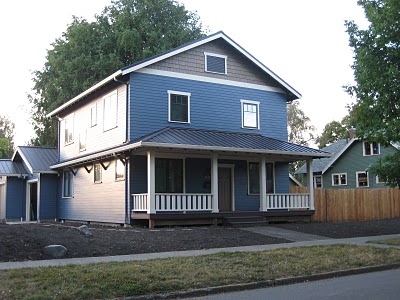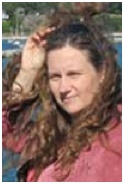One night when Mike and I were still living in Urbana, we sprung for a babysitter and headed to a nearby bar to hear some live music. The band was fun, the place was packed, and two young strangers invited us to share their table.
Through the din of the band and the beer we managed to make conversation and discover that the two of them were newlyweds, both working as architects in Chicago. Katrin was born in Germany. Nic was born near Urbana. They were in town that weekend looking for an inexpensive empty lot where they could build something called a Passive House. I couldn’t make out Nic’s explanation of what a Passive House was, exactly, but before the night ended, Katrin had slipped a business card to Mike, and we promised we’d let them know if we heard of any property for sale.
The next time we saw Katrin, she was a widow. Nic had an undiagnosed brain tumor. He died suddenly. Unexpectedly. Katrin
left Chicago and moved to Urbana alone, determined to build a Passive House in Nic’s memory.
The Passive House concept began in Germany and represents today’s most stringent — most aggressive, you might say — building energy standard. Buildings are constructed or retrofitted to cut the standard slash heating/cooling energy consumption by a whopping 90%. Windows usually face the southern sun, but the Passive House goes a lot further. Passive House construction uses thick walls and super-insulation — a wall of a Passive House is about three times as thick as a typical building. The buildings are super-tight; they use tape-sealed construction to keep cold out, and heat in, during the winter. Vice-versa during the summer. That means air doesn’t leak in or out through cracks and holes. But the air quality is still fine — there is a constant, low level ventilator operating. And it uses a heat exchanger so that exhaust air (already heated) transfers heat energy to the incoming air. Mike told me that some homes are heated with the equivalent of a blow dryer. Most don’t need a conventional furnace — or cooling system. Katrin told me that if Americans started using the Passive House design it would help energy conservation in the United States, her new home.
Twenty-five thousand certified passive structures — from schools and commercial buildings to homes and apartment houses — have been built in Europe. Katrin Klingenberg’s Smith House, completed in Urbana in 2002, was the very first Passive House built in the United States. Her determination to get the Passive House standard, literally, off the ground in America did not end with the completion of the Smith House. Local builder Mike Kernagis pitched in on other Passive House projects in Urbana, and in 2007, he and Katrin founded a non-profit called Passive House Institute US (PHIUS). They asked my Mike to sit on the board, and he’s been involved ever since. Since the completion of Smith House, more Passive House structures have been built in the United States, with more in the works. From a story in last September’s New York Times:
Ms. Klingenberg echoes many building science experts when she calls for more rigorous standards for energy-efficiency benchmarks, particularly if there is to be any hope of tackling the environmental and climate problems related to the nation’s dependence on fossil fuels. “We have to stop using halfway measures,” she says. “Each new building that we don’t go all the way with now is putting us deeper in the hole.” Ms. Klingenberg was a co-founder of the institute in 2008, intending it as a domestic outlet for the design philosophy espoused for the last 14 years by the passive-house movement’s official sanctioning body, the Passivhaus Institut in Darmstadt, Germany.
To date, Passive House Institute-U.S. has educated about 160 builders, architects and engineers in the standard through a series of training programs and a final certification exam. By year-end, the number is expected to be 300, and Ms. Klingenberg said the institute was having difficulty meeting demand for its courses.
The PHIUS board is meeting in Chicago this weekend, and of course Mike will be attending. Not as a board member, though — as an employee! PHIUS needed someone else on staff to help meet the growing demand for information on the Passive House energy standard, and in January they hired Mike as Director of Marketing and Outreach. Learn more about Passive House Institute U.S. in a February article in USA Today and in another recent article in the Chicago Tribune.
If you like what you read, check out the PHIUS Web site or the PHIUS Facebook page.


Sounds great!
Great post, as always Beth, except there seems to be a formatting problem in the fourth paragraph. Congratulations Mike, good to see your skills are being valued. Life is also going well for Brian, I note.
– Tracie
Thanks for letting me know about that formatting problem, I hope I fixed it!
And yes, sounds like things *are* going well for our peripatetic nephew Brian. Just heard he found a publisher for his story and photos on the bull run. What a guy!
Does this mean you’ll be moving down to Urbana?
You know, Passive House Institute U.S. is based in urbana, but the founders travel so much to speak at conferences and do training sessions and stuff that they aren’t there very much themselves. Mike goes down there from time to time but does a lot of his work from home. PHIUS is looking for an office manager for the Urbana HQ, though –if you know anyone looking for part-time work in urbana, please contact Mike Knezovich!
You sure do meet interesting people in bars.
Good for Katrin and congratulations to Mike. Hope the meeting goes well this weekend. It would be great if more builders got on board and used Katrin’s ideas when building new homes.
Thanks for the good wishes, Cheryl. Sounds like the board meeting went well –Katrin stayed overnight with us last night and we were all in good spirits. She heads to Boston this morning to give a workshop there –busy gal!
Interesting. Congrats Mike.
Very interesting–as always. Thanks for the post, Beth, and congratulations to Mike! Doing work you love and believe in makes life that much sweeter.
Wonderful reading. Very informative. So glad Katrin is making such a success. Mike, you are perfect for the job. Life can be so great!
Agreed: Mike *is* perfect for the job, and life can be great!
Urbana should feel proud.
How exciting that Mike has a new job with such an interesting group! I’d say Katrin maybe very busy in the future….with the Lybian situation and the cost of oil, people will have to look to alternative energy sources for not just their automobiles, but their homes. Maybe the “passive” will become to homes what the “hybrid” has become to autos….it could happen!
Great to hear about Mike’s new position! What a valuable organization. . .it all makes so much sense but it’s getting us Americans out of our mindset that’s the challenge. Best wishes to Mike in his new role, it sounds like a great place to be.
[…] Read more >> […]
Congratulations to Mike! I hope the concepts continue to grow and gain success.
I always knew he was passive…seriously, he gets involved in the greatest things! Congratulations, Mike.
Ha! Kris, only a sister would know! Maybe compared to your mom, Esther, Mike is passive? Thanks for the comment, I’ll pass it along to your baby brother.
Congratulations to Mike Katrina and the Passive House team! The whole concept sound great to me!
Keep up the good work * We need you
[…] engineers, builders and others to design, build and test Passive House buildings. I think Beth explained Passive House in another blog post –a building that is certified to meet the Passive House standard uses only 10 to 20 percent of […]
Leave a Response